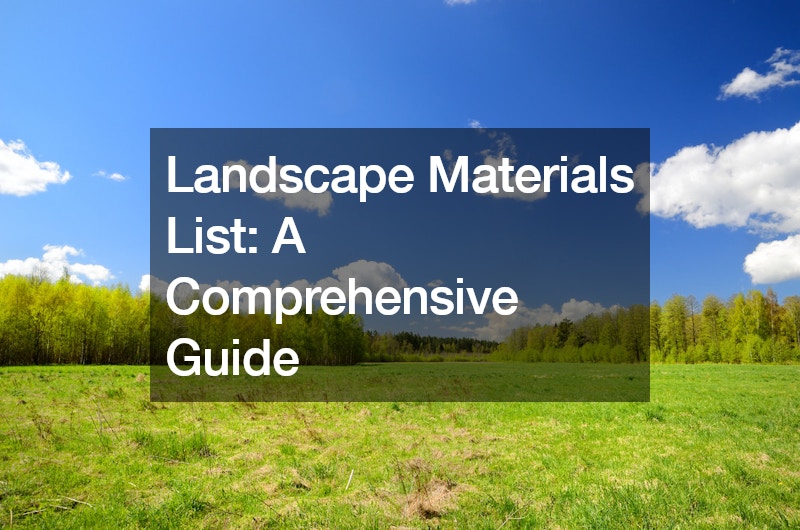
Getting The Most Out of Your Yard
Creating a beautiful and functional outdoor space requires careful selection of the right landscape materials. From natural stones to synthetic options, the variety of available materials can transform a simple garden into a stunning landscape. The right materials not only enhance the aesthetic appeal of a property but also contribute to its functionality and sustainability. Whether you are a homeowner embarking on a DIY project or a professional landscaper, understanding the different types of landscape materials and their uses is crucial for achieving the desired results.
When considering landscape materials, it is important to think about durability, maintenance requirements, and environmental impact. Natural materials such as stone and wood offer timeless beauty and strength but may require more upkeep. On the other hand, synthetic materials like composite decking and artificial turf provide low-maintenance alternatives that can withstand harsh weather conditions. By compiling a comprehensive landscape materials list, you can ensure that every element of your outdoor space is thoughtfully chosen to meet both aesthetic and practical needs.

Essential Tools for Landscape Projects
Every successful landscaping project begins with the right set of tools. Whether you’re planting a garden, installing a patio, or building a retaining wall, having the essential tools at your disposal can make the process smoother and more efficient. Basic tools such as shovels, rakes, and wheelbarrows are indispensable for moving soil, mulch, and other materials. For more intricate tasks, power tools like chainsaws and tillers can save time and effort. A well-rounded landscape materials list should include these essential tools to ensure that you are prepared for any project.
For larger or more complex landscaping projects, specialized tools and services may be necessary. For example, if your project involves metal elements like fences or decorative structures, a local metal fabrication service can provide custom solutions tailored to your needs. Additionally, renting or investing in high-quality tools can significantly impact the quality and longevity of your work. Including both basic and specialized tools in your landscape materials list will help you tackle a wide range of projects with confidence and precision. Such as jobs involving a wedding reception venue.
Natural Stone Options for Landscaping
Natural stone is a popular choice for landscaping due to its durability, versatility, and natural beauty. Stones such as granite, limestone, and slate can be used for various applications, including pathways, retaining walls, and garden borders. Their unique textures and colors add visual interest and a sense of permanence to any outdoor space. Incorporating natural stone into your landscape materials list can elevate the overall design and provide long-lasting results.
When selecting natural stone for your project, consider factors such as the stone’s durability, maintenance requirements, and compatibility with other materials. For instance, granite is an excellent choice for high-traffic areas due to its hardness and resistance to weathering. On the other hand, softer stones like limestone may require more care but offer a more refined appearance. Additionally, using compostable adhesives can help ensure that your stone installations are environmentally friendly and sustainable. By thoughtfully choosing natural stone options, you can create a landscape that is both beautiful and enduring.

The Best Types of Mulch for Gardens
Mulch is an essential component of any garden, providing numerous benefits such as moisture retention, weed suppression, and temperature regulation for plant roots. Organic mulches, such as wood chips, straw, and compost, gradually decompose, enriching the soil with valuable nutrients. Inorganic mulches, like gravel, pebbles, and rubber, do not decompose but offer long-lasting coverage and aesthetic appeal. Including a variety of mulch types in your landscape materials list can help you address the specific needs of different areas within your garden.
Choosing the right mulch for your garden depends on several factors, including the types of plants you are growing, the climate, and your maintenance preferences. For instance, wood chips and bark are excellent for perennial flower beds, providing a natural look and improving soil structure as they decompose. On the other hand, gravel and pebbles are ideal for areas with high foot traffic or for creating decorative pathways. If you need assistance with large tree removals to make space for your garden, consider hiring a tree remover to ensure the job is done safely and efficiently. By carefully selecting and applying the appropriate mulch, you can create a thriving and visually appealing garden.
Using Gravel and Pebbles in Landscaping
Gravel and pebbles are versatile materials that can enhance the functionality and aesthetics of any landscape. They are commonly used for pathways, driveways, and decorative accents, offering a durable and low-maintenance alternative to traditional paving materials. Gravel and pebbles come in various sizes, colors, and textures, allowing you to create custom designs that complement the overall style of your outdoor space. Including these materials in your landscape materials list can add both practicality and beauty to your project.
When incorporating gravel and pebbles into your landscape, consider their specific characteristics and how they will interact with other elements. For example, fine gravel is ideal for creating smooth, walkable surfaces, while larger pebbles can be used for decorative borders and ground covers. It is also important to ensure proper drainage to prevent water accumulation and erosion. If your landscape has experienced water damage, a water restoration contractor can help address any underlying issues and ensure your gravel installations remain intact. By understanding the various applications and benefits of gravel and pebbles, you can effectively integrate these materials into your landscape design.

Wood and Composite Materials for Decking
Decking is a popular feature in many landscapes, providing a comfortable and attractive outdoor living space. Wood has long been a favorite material for decking due to its natural beauty and strength. Options like cedar, redwood, and pressure-treated pine are commonly used for their durability and resistance to insects and decay. However, wood requires regular maintenance, including staining and sealing, to preserve its appearance and longevity. Adding wood decking to your landscape materials list can create a warm and inviting atmosphere in your outdoor area.
Composite materials are an increasingly popular alternative to traditional wood decking. Made from a blend of wood fibers and recycled plastics, composite decking offers the look of wood without the high maintenance requirements. It is resistant to rot, insects, and fading, making it an ideal choice for busy homeowners. When planning a major remodeling project that includes deck construction, consider the benefits of composite materials for a durable and eco-friendly solution. By weighing the pros and cons of wood and composite options, you can choose the best decking material to suit your needs and preferences.
Synthetic and Artificial Landscape Materials
Synthetic landscape materials have become increasingly popular due to their durability, low maintenance, and versatility. These materials, such as artificial turf, synthetic decking, and rubber mulch, provide practical solutions for homeowners looking to create attractive and functional outdoor spaces with minimal upkeep. Artificial turf, for example, offers the lush appearance of natural grass without the need for watering, mowing, or fertilizing. Adding synthetic materials to your landscape materials list can help you achieve a beautiful yard that remains green and vibrant year-round.
When incorporating synthetic materials into your landscape, consider their specific benefits and limitations. For instance, artificial turf is ideal for areas where natural grass struggles to grow, such as shaded spots or regions with water restrictions. Similarly, rubber mulch is an excellent choice for playgrounds and high-traffic areas due to its shock-absorbing properties and resistance to decomposition. If your project involves installing an irrigation system, lawn sprinkler installation can ensure that any natural plantings receive adequate water.

Innovative Paving Solutions for Outdoors
Paving is a critical element in landscape design, providing both functionality and aesthetic appeal. Traditional paving materials like concrete, brick, and natural stone are popular choices, but innovative solutions such as permeable pavers and recycled materials are gaining traction. Permeable pavers allow water to pass through, reducing runoff and promoting groundwater recharge. Recycled materials, including reclaimed bricks and pavers made from recycled plastics, offer environmentally friendly alternatives that contribute to sustainable landscaping. Including a variety of paving options in your landscape materials list can help you create unique and eco-conscious outdoor spaces.
When planning a paving project, consider the specific requirements of your site and the desired look of your finished space. For instance, permeable pavers are ideal for driveways and patios in areas prone to heavy rainfall, as they help prevent water pooling and erosion. On the other hand, recycled materials can add character and a sense of history to your landscape. If you are undertaking a major renovation that includes paving, working with a pool renovation company can ensure that any surrounding hardscape complements your pool area.
Sustainable and Eco-Friendly Materials
Sustainability is an important consideration in modern landscape design, with many homeowners and professionals seeking eco-friendly materials to minimize environmental impact. Sustainable landscape materials include options like recycled glass, reclaimed wood, and organic compost. These materials not only reduce waste and conserve natural resources but also often require less energy to produce and transport. By prioritizing sustainable options in your landscape materials list, you can create beautiful outdoor spaces that support environmental health and biodiversity.
Choosing sustainable and eco-friendly materials involves evaluating their life cycle impacts and how they interact with the local ecosystem. For example, using reclaimed wood for decking or garden structures helps reduce deforestation and gives new life to salvaged materials. Similarly, incorporating organic compost into your soil improves plant health and reduces the need for chemical fertilizers.
Sustainable and Eco-Friendly Materials
Sustainability is an important consideration in modern landscape design, with many homeowners and professionals seeking eco-friendly materials to minimize environmental impact. Sustainable landscape materials include options like recycled glass, reclaimed wood, and organic compost. These materials not only reduce waste and conserve natural resources but also often require less energy to produce and transport. By prioritizing sustainable options in your landscape materials list, you can create beautiful outdoor spaces that support environmental health and biodiversity.
Choosing sustainable and eco-friendly materials involves evaluating their life cycle impacts and how they interact with the local ecosystem. For example, using reclaimed wood for decking or garden structures helps reduce deforestation and gives new life to salvaged materials. Similarly, incorporating organic compost into your soil improves plant health and reduces the need for chemical fertilizers. If your project involves outdoor lighting, partnering with a landscape lighting company that specializes in energy-efficient solutions can further enhance your landscape’s sustainability.
Tips for Choosing the Right Landscape Materials
Selecting the right landscape materials for your project can be a daunting task, given the vast array of options available. It is important to consider factors such as durability, maintenance requirements, cost, and environmental impact when making your choices. Conducting thorough research and consulting with professionals can help you compile a comprehensive landscape materials list tailored to your specific needs and preferences. By carefully evaluating each material’s pros and cons, you can make informed decisions that enhance the beauty and functionality of your outdoor space.
One practical tip for choosing landscape materials is to match them to the specific requirements of your project. For example, if you are installing a new garden bed, consider using compostable adhesives to secure your materials in an eco-friendly manner. Similarly, if your project involves the installation of a new irrigation system, an electrical spreader can help you evenly distribute water and nutrients across your lawn.
Wrapping Up Your List
Creating a beautiful and functional landscape involves careful planning and thoughtful selection of materials. From natural stones and mulch to synthetic alternatives and innovative paving solutions, each material offers unique benefits that can enhance the overall design and sustainability of your outdoor space. By compiling a detailed landscape materials list, you can ensure that every aspect of your project is well-planned and executed with precision.
Incorporating eco-friendly and sustainable materials into your landscape not only helps protect the environment but also adds value and longevity to your property. Partnering with specialized services, such as local metal fabrication, tree removers, and landscape lighting companies, can further enhance the quality and efficiency of your project. By following these guidelines and carefully choosing the right materials, you can transform your outdoor space into a stunning, sustainable, and functional environment that you can enjoy for years to come.



